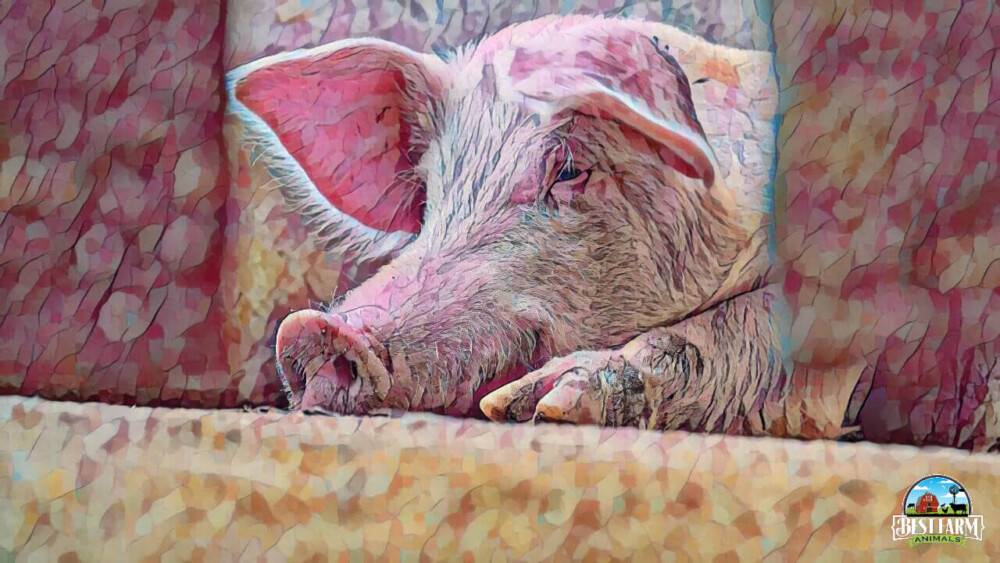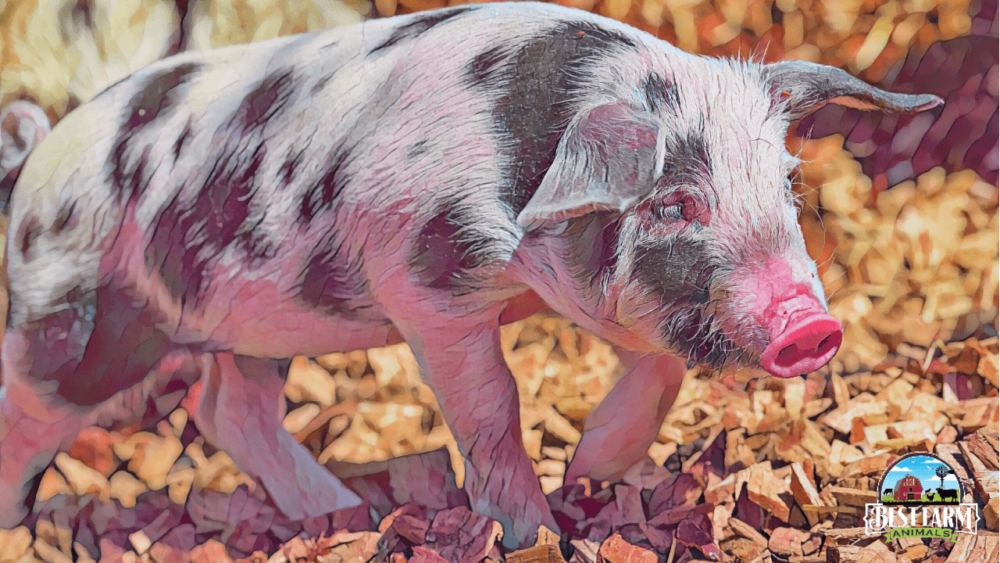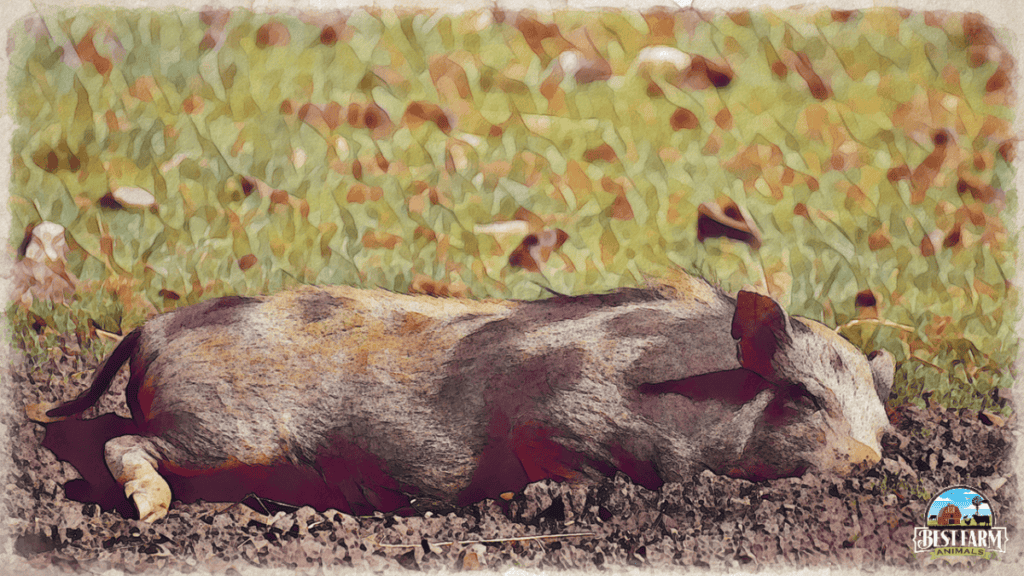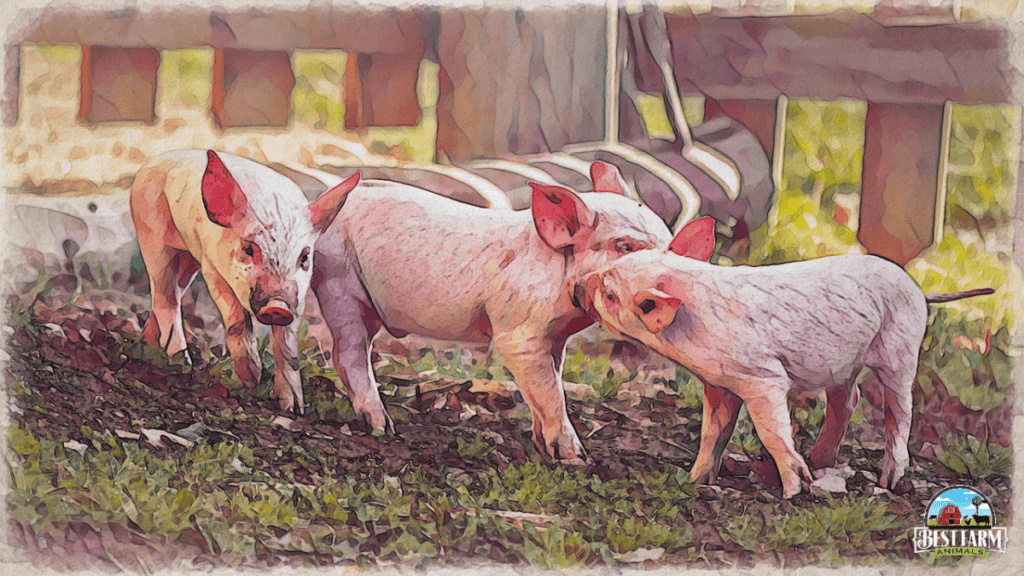Whether you have pigs as pets or are breeding pigs to generate an income, seeing your pig struggle to walk is stressful.
Table of Contents
I have a small piggery on my smallholding, and it went well until my newborn piglets developed splay leg syndrome. Before the big day, I had everything ready for the farrowing (birth) of the piglets, but the last thing I expected was to find them shuffling on the ground and struggling to get up. I had prepared the farrowing rooms and dried off the piglets when they were born. What could I possibly have overlooked?
Distressed, I called a local vet.
Why is my pig struggling to walk? Pigs struggle to walk from diseases and infections such as bush foot, arthritis, Teschen disease, osteochondrosis, torn ligaments, and tendons. Splay leg syndrome and dippity pig syndrome are also common causes. Unique accompanying symptoms can help to identify which disease is causing walking struggles.
Once you successfully identify the cause, you can administer the correct treatment and avoid irreversible damage.
I was busy cleaning the pigsty when I noticed one of my pigs walking on their knees. When I tried to get close, my pig squealed and struggled to get back onto its feet. I noticed it had a swollen claw, which was hot to the touch.
The signs accompanying pig lameness will help you identify the root cause.
Limping Pig: 7 Reasons Your Pig Has Leg Problems
The vet asked if the piglets had been farrowed in a room with a hard floor that may have been slippery. I had overlooked this and did not realize how a slippery floor would affect my piglets.
The vet also advised that healthy piglets should be suckling, grunting, and walking around without difficulty. It’s essential to take note of the symptoms and the potential cause of your pig struggling to walk.
Watch For:
- Walking on the knees
- Hind legs look paralyzed
- The pig is sitting in a dog-sitting position with the front legs standing and the back legs sitting.
- Your pig is showing signs of pain
Let’s take a closer look at five of the reasons why pigs struggle to walk:

Bush Foot or Foot Rot (Septic Laminitis)
Bush Foot is a disease that affects the tissues that connect the pig’s bone to the hoof. It causes severe inflammation and is painful. Bush foot or foot rot is also known as Septic Laminitis.
Pig bush Foot (Foot Rot) occurs when the skin of a pig’s foot is cut and infection enters. The foot becomes swollen and hot to the touch. It causes inflammation and redness in the hoof area. Pigs with Bush Foot often experience a reluctance to walk or become lame because of the pain. In other animals, Bush Foot is referred to as Foot Rot and can be caused by wet conditions.
Treating Bush Foot
Bush Foot is treated by administering oral antibiotics promptly to prevent the formation of an abscess. Urgent debridement is necessary to drain the pus if an abscess has already developed. Anti-inflammatory injections are given to reduce swelling and alleviate pain. These injections aid in the internal healing of the pig.
Footbaths containing 1% formalin are also used to treat the infection. The pig’s foot must be walked through the footbath once a week until the infection clears.
In cases where antibiotic treatment fails, amputation of the pig’s leg may be required to prevent death from septicemia.

Pig Arthritis Causes Pig to Walk on Front Knees
Pig arthritis is caused by a bacterial infection, trauma, or lesions that develop into inflammation in the joints of the pig’s legs. It causes pigs to walk on their knees. Suckling piglets and sows are more likely to develop arthritis due to a bacterial infection resulting from trauma or lesions.
Mycoplasma arthritis and Erysipelas arthritis is rarer in piglets, but can be found in growers after 10 weeks as the maternal antibodies dissipate.
Treating Arthritis
Administer antibiotics to treat the infection, and anti-inflammatories will help reduce the joints’ swelling. If the bacteria enter the bloodstream, septicemia will set in before arthritis develops. Septicemia can result in death.
If the pig is obese, feed them a good low-calorie diet to ensure a healthy weight. Frequently vaccinating your pigs will help prevent arthritis. Ensure that the floors are clean so there is no risk of your pig slipping, scraping their joints, and developing lesions.

Teschen Disease
When I went over to feed my pigs, I realized that one of my sows was missing. I found the sow standing by the water trough, swaying unsteadily. I saw her hobble away and drag a back leg as I approached.
My poor pig was suffering from Teschen disease.
Teschen disease is an infection (PTV-1) that attacks the motor nerves of pigs and causes muscle paralysis and eventually complete hind leg paralysis. The pig will still be able to feel sensations such as pin-pricks and hot or cold temperatures. It is caused by strains of porcine teschovirus serotype 1 (PVT-1).
Treating Teschen Disease
It’s best to administer preventative vaccinations against Teschen disease to prevent your pig or herd from becoming infected. A vet will also administer antibiotics to fight the infection.
Unfortunately, there is no effective treatment, so preventative measures are necessary (like keeping the sty hygienic and providing freshwater). Teschen disease can destroy the motor nerves of the pig, resulting in irreversible damage.

Osteochondrosis Condition
While bathing my pig with the hose, I noticed that the hip joint had become inflamed. My pig also kept one foot lifted off the ground. Skeletal diseases like osteochondrosis can suddenly cause a back leg to stop working correctly.
It’s stressful to see your pig hobbling around and dog-sitting with their hind legs outstretched before them. Osteochondrosis is a skeletal disease that affects the pig’s cartilage. This condition leads to leg weakness and stiffness and is often a result of trauma. It affects about 10% of all finishing pigs and is more common in young breeding pigs.
Treating Osteochondrosis Syndrome
Transfer the pig to a pen furnished with soft bedding, as it will assist the pig in obtaining a firmer grip while trying to stand.
It is important to ensure that the floors are not slippery and are regularly pressure-washed to minimize the risk of infection in case the pig falls or experiences trauma that could expose the skin and allow bacteria to enter.
Dippity Pig Syndrome
It was by far the most terrifying thing I had seen: my pig was fine one minute, and the next minute was squealing as sores started appearing all along the side of the belly. Dragging back legs can be either a sign of paralysis, or a case of dippity pig syndrome. The diseased skin of this condition can cause temporary lameness in pigs.
Pigs affected by Dippity Pig Syndrome typically emit frantic squeals and experience difficulties walking without stumbling or falling down. They often struggle with the functioning of their hindquarters and exhibit arching of the back.
Evidence suggests that this syndrome may have a hereditary component in pigs. Additionally, factors such as sunburn, stress, and even loud claps of thunder have been known to trigger the onset of this condition.
Treating Dippity Pig Syndrome
The best thing you can do for your pigs is reduce their stress. Playing soft music will help them relax. Ensure they are always well hydrated. Keep your pig comfortable. Hydrocortisone creams prescribed by your vet will also help alleviate the pain when applied twice daily (or according to your vet’s instructions).
Luckily this syndrome only lasts a couple of days (two to four days max) and should resolve without too much intervention. Even so, it’s still a painful and traumatic experience for your pig.

Torn Ligaments or Tendons
Usually, when I call my pigs for supper, they come rushing over. My one pig just lay on the ground, shivering and refusing to move. A pig doesn’t say no to a meal, so I was instantly alerted that there being something wrong. I feared a torn ligament.
Treating Torn Ligaments or Tendons
To assist in preventing further damage to the torn ligament, it is recommended to relocate your pig to a grassy area, as it provides better ground traction. Administering anti-inflammatory medication to your pig will aid in healing, facilitating a prompt recovery.

Porcine Congenital Splay Leg Syndrome (PCS)
Porcine congenital splay leg syndrome is a common disease that affects piglets and causes the most deaths. Splaying of the legs often happens due to the piglets being born on a slippery surface. The slick surface causes the legs to splay outward when the piglet attempts to stand.
Treating PCS
If the piglet experiences front leg splay, euthanasia is the most humane option, as the damage is irreversible. Hind leg splay (if caught in time) can be treated successfully. Encourage the piglet to suckle as soon as possible. Colostrum will encourage healing. about 5 minutes every few hours to encourage blood flow.

Limping Pig FAQs
Limping in pigs is a common condition, but it can cause severe issues if left untreated. Unfortunately, not all medical conditions can be avoided, but there are certain precautions you can take to help prevent the herd from developing conditions that affect their health and ability to move.
Can a pig recover from lameness?
With the proper care and treatment, most pigs can recover from lameness. However, in severe cases or when the limping pig has gone untreated for too long, the only option is to euthanize the pig. To avoid this, ensure your pigs are vaccinated regularly and monitor them for any signs of lameness or the presence of factors that could cause it.
Can pigs stand on their hind legs?
Pigs can’t stand on their hind legs without support. Pigs are heavy animals whose hind legs aren’t strong enough to support their full upright body weight. A pig can only stand on their hind legs if they hook their front legs over a fence or railing for support. Young piglets may hop onto their back legs while playing, before they become too heavy.
Can a pig have a stroke?
Pigs don’t have strokes. However, they do commonly suffer from seizures. Pigs can have as many as one or two seizures a day. The number differs from one pig to another, but most pigs don’t require medication for seizures.
Is pig paralysis contagious?
Teschen disease in pigs causes paralysis. This infection can spread to other pigs in the herd through the infected pig’s feces. To avoid the spread of the disease and resulting paralysis, keep the sty clean and make sure to sanitize your boots and equipment regularly.
Place a sanitizing bath at each of the pig sties to clean your boots before entering.
How do I know if my pig is in pain?
A clear indication that your pig is in pain is if they suddenly squeal or scream. They may also limp or lie down for extended periods. A pig in pain may also present with aggressive behavior and shallow breathing.
Conclusion
Pigs are lovely animals to keep as pets or farm with, but you need to observe them closely, especially when they struggle to walk. Sometimes your pig will alert you by screaming or squealing, and others may simply lie on the ground and refuse to move.
Monitoring your pigs daily will make it easier for you to spot the signs that your pig struggles to walk. Early detection of infections and diseases will prevent irreversible damage.
References
National Library of Medicine:
Congenital Splay Leg Syndrome in Piglets—Current Knowledge and a New Approach to Etiology
Purina Mills:
My Most Used Pig Supplies
This list contains affiliate products. Affiliate products do not cost more but helps to support BestFarmAnimals and our goal to provide farm animal owners with accurate and helpful information.
Purina Pig Chow will last well (or Mazuri is popular, but I haven’t tried it), and the stainless steel non-skid bowls that will help keep the mess down.
A pig blanket to keep her warm. This one also has bright colors and helps to provide rooting without the destruction.
Pig Harness for walking and handling your pig. There are a lot to choose from, but this one is pretty easy to use. If you want one that has a separate leash, this looks like a good one.
A large crate for keeping her safe in your house at night and when you leave the house. This is essential. You’ll also want a litterbox, and I like mine with a lid for nighttime. Pine shavings are best, and you may be able to find them in larger quantities locally.
When you have accidents, Odoban will help eliminate odors. When you are potty training, these floor pads work great for keeping your house clean while training her to go in certain places.
You’ll also want an outdoor house to keep her warm when she gets outside time, an essential part of her development.
Dewormer- Ivermectin is the primary dewormer I use, although I do rotate with a non-ivermect ingredient once so that the worms don’t get immune to it.

